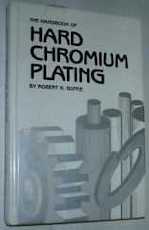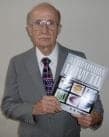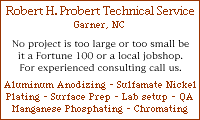
Curated with aloha by
Ted Mooney, P.E. RET

The authoritative public forum
for Metal Finishing 1989-2025

-----
Hard Chrome Plating of Inconel Q&A, Problems & Solutions
Quickstart:
Chrome plating generally must be done directly on an active metal surface, not on oxide or other passive layers. Inconel & Hastelloy alloys and some stainless steels are high in nickel content, and nickel readily passivates.
It is important to NOT anodic clean nickel & nickel alloys because that increases the passivity. After cathodic cleaning, a cathodic etch, preferably in chromic acid is the most generally suggested activation process, although some believe that a mix of sulfuric and hydrofluoric acid should be used. Yet another alternative is to do a Wood's nickel strike.
Inconel 718: 50-55% nickel, 17-21% chromium
Q. Hi I'm trying to plate Inconel 718 with hard chrome but facing several issues including peel off, no adhesion, adhesion only on certain parts.
Can someone help provide a right way to plate inconel?
- India
October 14, 2024
Ed. note: This forum was designed to help build camaraderie through sharing of tips, pics, anecdotes, & opinions.
When people withhold their names, readers who come here for that are less likely to engage.
Hard Chrome over Inconel 625 cladding
Inconel 625: >= 58% nickel, 20-23% chromium
Q. Prep and adhesion concerns plating in a Hard Chrome non-fluoride conventional bath.
Rather large drums if anyone has any suggestions
by Robert K. Guffie

on AbeBooks
(rarely)
or eBay
(rarely)
or Amazon
(affil links)
employee - Illinois
January 20, 2025
Ed. note: This forum was designed to help build camaraderie through sharing of tips, pics, anecdotes, & opinions.
When people withhold their names, readers who come here for that are less likely to engage.
A. In addition to what you'll read on this page and its referenced links, Guffie ⇨ stresses the importance of cathodic rather than anodic cleaning, and recommends reverse etching in chromic acid.
Luck & Regards,

Ted Mooney, P.E. RET
Striving to live Aloha
finishing.com - Pine Beach, New Jersey
⇩ Related postings, oldest first ⇩
Q. I am trying chrome plating (FED QQC 320) on Inconel investment castings to a thickness of 0.2-0.3 mm. The plating is to be done in a through cylindrical hole of about 6 inches long and an internal diameter about 4 inches. However, I am faced with poor adhesion problem. When removed from chrome tank at mid time, the chrome plated layer appears to be OK. However, after re-immersing into chrome tank and plated to required thickness, the plated layer start showing some localized non-adhesion problem. It peels of chips off (between chrome layer and base metal)when lightly knocked at the pump up spot. Some porosity also appears. Before chrome plate, we bake the parts in oven, degrease, sand blast and rinse thoroughly with hot DI water. We have chrome plated similarly on stainless steel parts without problem.
Is there a difference between chrome plating of Inconel and Stainless steel material (such as chrome solution, temperature, current, plating jig or anode used etc ) ?
Any advice would be much appreciated.
Tan Pang Choon / PC Tan- Singapore
2002
2nd Request
Q. Dear friends,
I am still facing with the same adhesion problem when chrome plating the Inconel 718 casting. There was suggestion that we should try Wood's Nickel Strike before dipping parts into the chrome bath will help. Could anyone help to provide more details on what exactly is "Woods Nickel Strike", please?
Thank you,
Tan Pang Choon / PC Tan [returning]- Singapore
A. Mr Tan Pang,
If you read threads 123/98 and 251/60, there have I described the pretreatment steps for Inconel alloy.
Sincerely,

Anders Sundman
4th Generation Surface Engineering
Consultant - Arvika,
Sweden
Ed. note: Khair Shishani confirms success with the same H2SO4-HF process on thread 251/60.
A. A Wood's Strike, also called a Nickel Chloride Strike is 2 pounds per gallon Nickel Chloride plus 2 quarts per gallon Hydrochloric Acid, room temp, 50 amps per square foot, 3 to 5 minutes, fast transfer to rinse and on to chrome tank. Use Rolled Depolarized anodes and take the anodes out when not in use.
To plate chrome on chrome when you take the part out "mid-cycle" you must reverse current treat for two minutes before resuming cathodic plating.

Robert H Probert
Robert H Probert Technical Services
Garner, North Carolina

|
Q. Thanks for the info, friends. Dear Anders, I visited thread 12398. You indicated that it is important that parts must have the same temperature as the chrome solution have. What steps do I need to take to ensure this? Dear Robert, Is the Wood's nickel strike to be done with anode or cathode and what is the proper material ? What is "Rolled Depolarized anodes ? Is it used in chrome bath or Woods nickel strike bath ? What is the material and how to depolarize? Thanks again for the your clarification. Regards, PC Tan [returning]- Singapore A. We hard chrome plate Inconel successfully by using a nitric/HF predip of 3 parts HF to 1 part nitric to activate. After a through rinse, go directly into the bath hot (apply current to the part as you put the part into the bath. All we give it is a good wet hone prior to the HF/nitric dip. We plate Inconel almost everyday with great success.. Good Luck, David Ackley- Peoria, Arizona, USA |
A. PC,
Let part hang in the chrome solution until the part has the same temperature as the chrome solution 2-5 minutes before you increase the current.
Regards,

Anders Sundman
4th Generation Surface Engineering
Consultant - Arvika,
Sweden
A. There are many good suggestions here for improving adhesion. Activation and/or a nickel strike will work, but be aware that you may drag in undesired anions into your chrome bath. You are probably seeing delamination at thicker chrome deposits due to increased tensile stresses. If your customers spec allows, there are ways to decrease stress in the deposit, like the addition of Indium sulphate. Before you make any changes on your line, research first, make sure you understand fully what people are suggesting.
Steve Delaney- Ontario, Canada
Q. David,
You mention a Nitric/HF pre-dip for hard chrome plating of Inconel. Is this diluted with water or used as a concentrated solution from the Nitric and HF acids? Is it used anodically or as a dip? How long should the parts be left in the Nitric/HF dip?
Frank Meegan & Associates. - Ratoath, Co. Meath, Ireland.
September 9, 2008
Multiple threads merged: please forgive chronology errors and repetition 🙂
How to do chrome plating on "Inconel" (70% Ni w/Ferrous and 18% Cr)?
Q. I'm serving in Automotive industry through a job working company in India near by New Delhi.
Ravinder NagarSr.Engineer-Process - Ghaziabad, New Delhi, India
2007
|
|
A. It is not as tough as plating on Waspalloy or Incolloy or Hastelloy, but it has to be clean and it has to be properly etched. There are a number of different etch makeups listed in numerous publications. I like a dip in a low to mid concentration of nitric-hydrofluoric acid with an excellent rinse and if you are having any problems, a strike in a Wood's nickel tank, rinse rapidly and immediately into the chrome tank. - Navarre, Florida A. See ASTM B558, 'Standard Practice for Preparation of Nickel Alloys for Electroplating'. Section 3 gives 4 activation methods, and the Appendix lists the appropriate method for each of 22 Ni-containing alloys. Possibly, your alloy requires an anodic + cathodic treatment in a modified Wood's nickel strike. Separate tanks are recommended (avoids contaminating the cathodic solution). Follow with the appropriate chromium plating procedure (ASTM B650 for hard chromium, ASTM B456 for decorative chromium). - Goleta, California Rest in peace, Ken. Thank you for your hard work which the finishing world, and we at finishing.com, continue to benefit from. |
A. Could you provide more info on type of part and type of hard chrome bath being used? We have experience in plating 751 alloy valves. We would plate 30,000 a shift for some customers without 1 rejected part.
Tim DeakinNorth Tonawanda, New York
Readers may be interested in this related thread:
• Topic 26129 "Getting chrome plating adhesion on Hastelloy & stainless"
Q, A, or Comment on THIS thread -or- Start a NEW Thread
